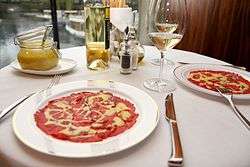Carpaccio
 | |
| Course | Hors d'oeuvre |
|---|---|
| Place of origin | Italy |
| Main ingredients | Raw meat or fish (beef, veal, venison, salmon or tuna) |
|
| |
Carpaccio (UK /kɑːrˈpætʃioʊ/ or US /kɑːrˈpɑːtʃⁱoʊ/; Italian pronunciation: [karˈpattʃo]) is a dish of raw meat or fish[1] (such as beef, veal, venison, salmon or tuna), thinly sliced or pounded thin and served mainly as an appetizer. It was invented and popularised by Giuseppe Cipriani from Harry's Bar in Venice during the second half of the twentieth century.[2] It was named after Venetian painter Vittore Carpaccio. The beef was served with lemon, olive oil, and white truffle or Parmesan cheese. Later, the term was extended to dishes containing other raw meats or fish, thinly sliced and served with lemon or vinegar, olive oil, salt and ground pepper.
History
The dish, based on the Piedmont speciality carne cruda all'albese, was invented in 1970[2] by Giuseppe Cipriani, founder of Harry's Bar in Venice. He originally prepared the dish for the countess Amalia Nani Mocenigo[3] when he learned that the doctors had recommended that she eat raw meat.[4] The dish was named carpaccio after Vittore Carpaccio, the Venetian painter known for the characteristic red and white tones of his work.[3]
Preparation

The typical Piedmont carpaccio is made with very thin slices of beef placed on a dish with lemon, olive oil, and shavings of white truffle or Parmesan cheese, and can be topped with arugula.
The meat typically used for carpaccio is beef sirloin. Since this dish is served raw, the meat must be fresh. Less commonly, reflecting Piedmont tradition, carpaccio can also be made with minced meat and garlic, called "carne cruda".
Modern usage
Today the term carpaccio is sometimes used for any preparation made with thinly sliced raw meat, fish or vegetables (usually seasoned with lemon, or vinegar, olive oil, salt and ground pepper) or fruit. Carpaccio is also a popular appetizer in neighbouring Friuli and Slovenia, where it is usually served on rucola with a slice of lemon, Parmesan cheese, and toasted French bread.
See also
References
- ↑ Oxford Dictionaries: http://www.oxforddictionaries.com/definition/english/carpaccio
- 1 2 Jan Morris (2014). Ciao, Carpaccio!. Liveright Publishing Corporation. p. 16. ISBN 978-0-87140-799-3.
- 1 2 Cipriani, Arrigo (1996). Harry's Bar: The Life and Times of the Legendary Venice Landmark. New York: Arcade. ISBN 1-55970-259-1.
- ↑ Beef carpaccio with rocket - The Times Online
Further reading
- Hierro, Eva; Ganan, Monica; Barroso, Elvira; Fernández, Manuela (2012). "Pulsed light treatment for the inactivation of selected pathogens and the shelf-life extension of beef and tuna carpaccio". International Journal of Food Microbiology. 158 (1): 42–8. doi:10.1016/j.ijfoodmicro.2012.06.018. PMID 22795799.
- de Alba, María; Bravo, Daniel; Medina, Margarita (2012). "High pressure treatments on the inactivation of Salmonella Enteritidis and the characteristics of beef carpaccio". Meat Science. 92 (4): 823–8. doi:10.1016/j.meatsci.2012.07.008. PMID 22863078.
- Vaudagna, S. R.; Gonzalez, C. B.; Guignon, B.; Aparicio, C.; Otero, L.; Sanz, P.D. (2012). "The effects of high hydrostatic pressure at subzero temperature on the quality of ready-to-eat cured beef carpaccio". Meat Science. 92 (4): 575–81. doi:10.1016/j.meatsci.2012.06.002. PMID 22749447.
- Bravo, Daniel; de Alba, María; Medina, Margarita (2014). "Combined treatments of high-pressure with the lactoperoxidase system or lactoferrin on the inactivation of Listeria monocytogenes, Salmonella Enteritidis and Escherichia coli O157:H7 in beef carpaccio". Food Microbiology. 41: 27–32. doi:10.1016/j.fm.2014.01.010. PMID 24750810.